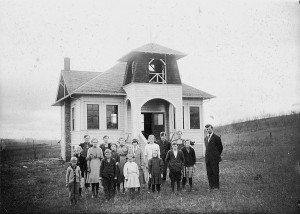
(Photo courtesy Benton County Historical Society)
The journey started with a mid-summer email: What do you know about Sunnyside School? The response added to a high-speed—at least in preservation terms—adventure in negotiations, fund-raising, and stick-to-it-iveness.
Corvallis’ century-old Sunnyside School was historically known as Bryant School and Mudflat School due to the surrounding swampy area and muddy roads. Before 1897, a one-room school house was built on a site approximately two miles north of downtown Corvallis. Around 1912, a Craftsman style school replaced the earlier schoolhouse on the same site. In 1929 when school districts reorganized, Sunnyside School closed, the property was sold, and the building started a new life as a residence.
In 2013, the owners of the school decided on demolition.
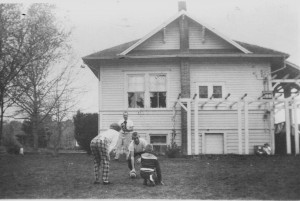
into residential use
(Photo courtesy Benton County Historical Society)
Enter the Preservation Hero
Julie Hansen, an active member of her local neighborhood association, had walked past Sunnyside daily. In recent years, as Comprehensive Plan Amendment and accompanying zone change applications threatened to densify Sunnyside’s single family residential neighborhood with even more student-focused townhomes, Hansen’s walks became more frequent.
When she got word of the pending demo, Hansen marshaled information and approached the property owner about saving the school, reusing the property, or selling it to her. Though unwilling to sell the land, the property owner was willing to consider a potential move, at no cost to them, if accomplished during fall months.
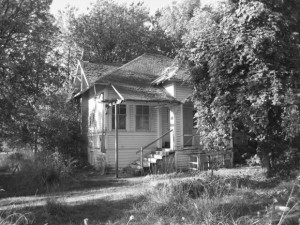
overgrown by plants (Photo courtesy BA Beierle)
Convinced that Sunnyside merited a public use, Hansen first approached the local school district that—although sympathetic—faced current budget and aging-facility challenges. Knowing that the City Parks & Recreation Department recently elevated nearby Knotts-Owens Farmstead to a priority project, Hansen met in early August with Parks management, an architect, and local preservationists on site. Despite deterioration, Sunnyside’s walls and roofline were straight and true. Parks Director Karen Emery acknowledged that Sunnyside School would meet existing Owens Farm masterplan needs for an educational facility, but that there was no budget for a serendipitous acquisition and move. Hansen pledged $100,000 on the spot for a move and the race was on.
Moving the School
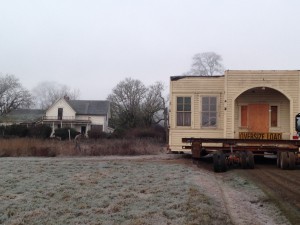
(Photo courtesy Roz Keeney)
Park Planner Jackie Rochefort developed a budget and strategy for the Sunnyside move. After consulting with house movers, engineers, and historians, a site at Knotts-Owens Farm was identified. Requisite approvals from the Parks & Recreation Commission, their Friends group, and City Council were secured, stabilization bids acquired, and a contractor selected.
Although the distance from its original location to its new Knotts-Owens Farmstead site was less than a mile, Sunnyside needed to pass under power lines that serve Good Samaritan Regional Medical Center, necessitating complex and expensive arrangements to assure uninterrupted power service to the hospital. An innovative plan that would remove the roof and move the school in separate segments allowed utility expenses to be avoided so the project could be closer to its $100,000 budget.
One of the best and oldest examples of early family farming in the Willamette Valley, Restore Oregon listed the Knotts-Owens Barn as one of Oregon’s Most Endangered Places. From 1849 to 2013, four generations of Knotts-Owens family members farmed there. With all the drama of a screenplay, during a routine drive past Sunnyside on a gray November day, the clouds broke and sunshine streamed down on Sunnyside School. Later that day, a capstone gift from the Owens family closed the Sunnyside project’s budget needs.
But wait, there’s more. Scott Taylor Construction agreed to donate the labor to prepare the school for the move, build a foundation, reinstall the roof, and secure and stabilize the building. Although the property owner’s window for completing the move was rapidly closing, they were persuaded to wait until the end of January before demolishing the structure. On a foggy January morning, Sunnyside School inched north one mile on Highway 99W and then slowly climbed the hill west of the Knotts-Owens Farmstead to its new location.
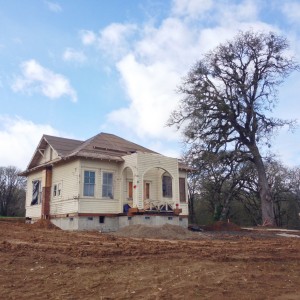
(Restore Oregon photo)
A Bright Future
Currently, Scott Taylor is rebuilding the missing Sunnyside bell tower. An assessment of the Knotts-Owens Barn is underway, as is a Preservation Plan for the historic Gothic Revival Farmhouse. Fundraising for physical work on the house and barn will come next, followed by continued rehab of the school. In coming years, the entire complex will be transformed into a regional education center for children and the public to learn about farming practices, both historic and modern.
Tax-deductible contributions for rehabilitation work at Sunnyside School or Knotts-Owens Farm may be sent to Friends of Corvallis Parks and Recreation, 1310 SW Avery Park Drive, Corvallis, OR 97333.

